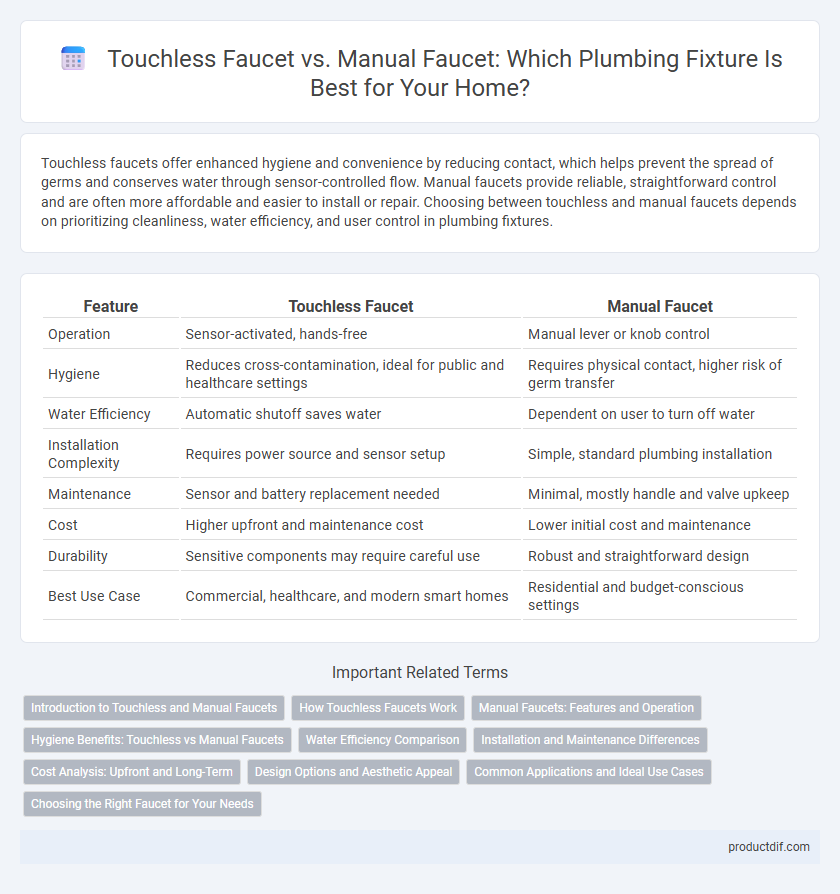Touchless faucets offer enhanced hygiene and convenience by reducing contact, which helps prevent the spread of germs and conserves water through sensor-controlled flow. Manual faucets provide reliable, straightforward control and are often more affordable and easier to install or repair. Choosing between touchless and manual faucets depends on prioritizing cleanliness, water efficiency, and user control in plumbing fixtures.
Table of Comparison
| Feature | Touchless Faucet | Manual Faucet |
|---|---|---|
| Operation | Sensor-activated, hands-free | Manual lever or knob control |
| Hygiene | Reduces cross-contamination, ideal for public and healthcare settings | Requires physical contact, higher risk of germ transfer |
| Water Efficiency | Automatic shutoff saves water | Dependent on user to turn off water |
| Installation Complexity | Requires power source and sensor setup | Simple, standard plumbing installation |
| Maintenance | Sensor and battery replacement needed | Minimal, mostly handle and valve upkeep |
| Cost | Higher upfront and maintenance cost | Lower initial cost and maintenance |
| Durability | Sensitive components may require careful use | Robust and straightforward design |
| Best Use Case | Commercial, healthcare, and modern smart homes | Residential and budget-conscious settings |
Introduction to Touchless and Manual Faucets
Touchless faucets utilize infrared sensors to detect hand presence, enabling hands-free operation that enhances hygiene and reduces water waste. Manual faucets rely on traditional handles or knobs to control water flow, offering straightforward and cost-effective functionality. Both types serve essential roles in residential and commercial plumbing fixtures, with touchless models gaining popularity for their convenience and sanitation benefits.
How Touchless Faucets Work
Touchless faucets use infrared sensors to detect hand movements, activating water flow without physical contact. These faucets employ electronic solenoid valves that open when the sensor picks up motion, ensuring water is dispensed only when hands are present. This technology improves hygiene by reducing germ transmission and enhances water conservation through precise control.
Manual Faucets: Features and Operation
Manual faucets require physical contact to operate, typically using handles or knobs to control water flow and temperature. These fixtures offer reliable, straightforward functionality without the need for batteries or sensors, making them low-maintenance and cost-effective. Their durable construction often includes ceramic disc cartridges that ensure smooth operation and prevent leaks over time.
Hygiene Benefits: Touchless vs Manual Faucets
Touchless faucets significantly reduce the risk of cross-contamination by eliminating the need for direct hand contact, making them ideal for maintaining high hygiene standards in both residential and commercial settings. Manual faucets, while common, require physical touch that can transfer bacteria and viruses, increasing the potential for surface contamination. Installing touchless faucets enhances cleanliness in kitchens and bathrooms by minimizing germ transmission and promoting healthier environments.
Water Efficiency Comparison
Touchless faucets typically use infrared sensors to control water flow, reducing water waste by shutting off automatically when not in use, leading to an average water savings of up to 30% compared to manual faucets. Manual faucets, relying on user operation, often result in longer water flow times and increased consumption, especially in high-traffic environments. Studies from the Environmental Protection Agency (EPA) highlight that touchless faucets significantly improve water efficiency in commercial and residential settings by minimizing unnecessary water use.
Installation and Maintenance Differences
Touchless faucets require sensor wiring and power sources, making installation more complex compared to manual faucets, which typically need only basic plumbing connections. Maintenance of touchless faucets involves battery replacement or electrical troubleshooting, while manual faucets primarily require periodic seal and cartridge replacements. Both types demand regular cleaning, but touchless models also need sensor calibration to ensure optimal functionality.
Cost Analysis: Upfront and Long-Term
Touchless faucets generally have higher upfront costs, ranging from $150 to $400, compared to manual faucets priced between $50 and $200. Long-term maintenance expenses for touchless models may be greater due to sensor repairs and battery replacements, whereas manual faucets usually incur lower ongoing costs. Energy efficiency and water conservation features in touchless faucets can reduce utility bills, partially offsetting higher initial investments over time.
Design Options and Aesthetic Appeal
Touchless faucets offer sleek, modern design options with smooth surfaces and integrated sensors that enhance aesthetic appeal in contemporary bathrooms and kitchens. Manual faucets provide a wide range of traditional and classic styles, allowing customization through various handle shapes, finishes, and spout designs to match diverse decor themes. The choice between touchless and manual faucets significantly impacts the visual harmony and user experience within the plumbing fixture environment.
Common Applications and Ideal Use Cases
Touchless faucets are commonly used in public restrooms, hospitals, and commercial kitchens due to their hygienic, hands-free operation that minimizes cross-contamination. Manual faucets remain ideal for residential applications and settings where precise temperature and flow control are required, such as home bathrooms and kitchen sinks. Each type suits different needs: touchless faucets enhance cleanliness and convenience in high-traffic areas, while manual faucets provide reliability and ease of maintenance in private or low-traffic environments.
Choosing the Right Faucet for Your Needs
Touchless faucets offer enhanced hygiene and water conservation by minimizing physical contact and controlling flow with sensors, making them ideal for high-traffic or commercial spaces. Manual faucets provide precise temperature and flow control with a simpler design, often preferred for residential settings due to lower cost and ease of repair. Evaluating factors such as usage frequency, maintenance capabilities, budget constraints, and water efficiency goals ensures selecting the right faucet that aligns with specific user needs and environments.
Touchless faucet vs Manual faucet Infographic

 productdif.com
productdif.com